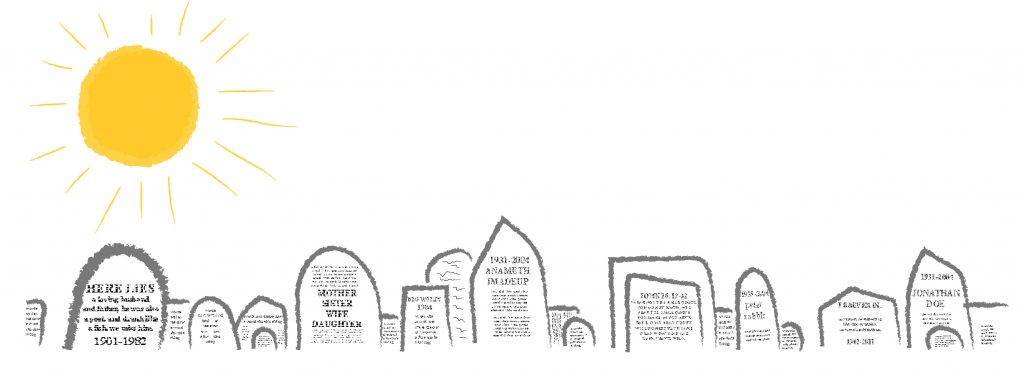No me llores, no
Porque si lloras yo peno
En cambio si tú me cantas
Yo siempre vivo y nunca muero
En cambio si tú me cantas
Yo siempre vivo y nunca muero
-Andrés Henestrosa, “La Martiniana”
When I first read Don Delillo’s White Noise, the only thing I found myself doing was rolling my eyes every three seconds. This is meant to be a good book, isn’t it? Delillo had always been sold to me as this fantastic American author, and though I was familiar (and frankly, not incredibly impressed) with some of his short stories – this novel was ridiculous. The two main protagonists spend all their time panicking over the idea of death and then, miraculously, there was mention of a medical trial for a drug that is meant to cure fear of death – and quite frankly it all feels extremely “been there done that.” Reminiscent of ridiculous slam poems written by obnoxious 15-year-olds, it lacked innovative subject matter, almost exclusively relying on shock value and linguistic minimalism in an attempt to be impactful. American consumerism and death are dealt with in the most obtuse, ham-fisted manner – there isn’t an ounce of creativity in the allegorical picture drawn by Delillo’s work; I wouldn’t recommend it to anyone.
This article is not, however, meant to be exclusively a hateful review of White Noise (as much as I wouldn’t mind going off about that for ages either).
This article is not even meant to be me hating on the general themes of postmodernist literature written by white men (again, I wouldn’t mind doing a deep dive exploration of the pointless, subtly bigoted anxieties of white American men from the 20th century onward).
I do, however, want to elaborate on why Delillo’s observation of death as an ever present anxiety made me feel annoyed rather than engrossed and intrigued. The themes of White Noise would have worked excellently had they been less clumsily dealt with. The reason the novel bothered me was because I find that its themes echo Western narratives surrounding death and the general anxiety that comes with the unknown. While death, across the world, has been the subject of a multitude of rites of passage, with its skeletal eyes staring directly into those who remain alive as a reminder of perishability and cyclical time movement, Western ideas of lineality and definitive endings do not permit many opportunities to engage with death at all. If anything, death remains a spectacle to stare at from afar, an individual phenomenon, existing outside of time, community, and the universal experience of humanity altogether.
Culturally, I come from a place that has a notorious celebration of the dead, where their lives beyond the grave are considered a guarantee rather than an anxiety. The interaction of life and death, of the known and the unknown, the liminality between dimensions of existence – they are all embraced rather than viewed through the distinctively Western rejection of ambiguity. Western ‘ways of knowing’ hate the “in between,” their anxieties toward death expressed in a refusal to have a frank discussion not only of death, but of any grey area whatsoever. I find that Delillo’s study of this anxiety does not criticize any of these elements by introducing new, different ways of knowing into the equation, but regurgitates sentiments of death as emptiness, demonstrating an incapacity to engage with death himself and making the novel vague and baseless in its observations, much like the aforementioned angsty slam poetry we all wrote when we first discovered our hatred for the world as adolescents, before discovering some nuance.
White Noise sat wrong with me because it reminded me of the vacancy that sat looming over death like an airborne toxic event (pun intended), expressing a refusal to discuss the “unknown” in an earnest fashion. The “unknown” is relegated to a feminized, othered dimension of existence where reality does not exist. The “unknown” is thus given the characteristics of the subaltern, the element that must be conquered and overcome rather than confronted with an acceptance of the otherness within oneself.
Memento moris scatter our everyday existence, they illuminate our lives with reminders of ephemerality, and make the fleeting nature of momentaneous existence brighter and more wondrous to behold. In Mexico, we see these in the form of cempasuchil flowers (somewhat like marigolds), with their golden petals illuminating the path between life and death, giving the empty silhouette of death a golden hue by coloring it in, defining the eternal return of the soul, the idea of death not as an ending but rather as a different facet of existence. The colors that decorate the faces of the skeletons in elegant garb are so bright that they give meaning and beauty to the contrasting blacks and whites that define the austere bone structure of the dead. The elaborate ornamentation that fills the empty spaces implies a recognition of the coexistence of both life and death, visually representing not anxiety but rather a lack of othering, a similarity instead of projecting insecurity onto the idea of death, its illustrious perception beyond dichotomy and Western paradigm.
Confrontations with death and spectral presences are scattered throughout Western literature as terrifying, supernatural experiences that are so terrifying due to their uncanny, unrealistic nature. What, however, makes death less real than everyday life? Is death only terrifying because it is beyond our everyday activity? It surrounds and imbues most of the forms in which we see the world, so why is death almost exclusively represented as a black shadow at the foot of your bed in a fit of sleep paralysis? Death is uncanny because Western imaginaries can largely only imagine it as a hollow sequel to life, illustrated in shades of black and charcoal as a form of darkness and panic. It is a mirror to life, but simultaneously not its own entity. It is a replica akin to life’s ugly sister; ignored, shunned, and placed in the corner to avoid being dealt with.
Death is stifled and silenced to the degree where most experiences with it become heinously traumatizing to those which have come across it, treated not as a call to reflection and memory but rather one of omission and avoidance that comes with vacancy. While Delillo’s characters attempt to cover this vacancy with mass consumerist behavior (an observation which rings true in many ways), his criticism and becomes embedded within the criticism of consumerism as a feminized anxiety placated by behavior that is hailed as “morally wrong” from a place that rings true to religious conservatism. His emotionless response to death, dealing with fear in a hands-on, masculine fashion treats death itself as a feminine subject, making Delillo’s novel one of gallant (outdated) conquest rather than one that attempts to deal with emotions and anxieties as valid tools to illustrate and discuss death.
Reframing the discussion around reconsidering the idea that the fear of death is an entirely primitive emotion is to recognize that it is in actual fact a manufactured fear, one that has been constructed to make death an enemy, a poisonous other that is fundamentally impossible to discuss considering the amount of euphemistic padding surrounding it. The Western fear of death, or at least the culture constructed around it has converted it into a taboo that is avoidant of natural progression and refuses its past as much as its future. Averted to the aging, reverting to victim-blaming the ill, and committed to the idea that death as much as the unknown is but an obstacle to be owned by the masculinized subject. The conception of time in relation to life and death as cyclical requires accepting a harmonious relationship between the two as much as the existence of balance and its importance. Moving away from hyperbolic criticisms of half-witted allegory, the way Delillo writes it onto more incisive analyses of the matter that weigh in a variety of subjectivities surrounding death set precedent for just that.

ABOUT THE AUTHOR: PAOLA CÓRDOVA
Paola hails from the faraway land of Mexico City, growing up in a household with an odd mixture of languages and cultures influencing the way she views the world. With a passion for film, literature, and most every variant of artistic expression (despite her lack of ability to make visual art herself), she hopes to write personal things that resonate deeply with the experiences of all kinds of individuals.




